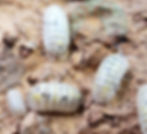Vulgare “Magic Potion”, What’s the Difference?
- Smug Bug
- Mar 13, 2021
- 2 min read
The “magic potion” morph of Armadillidium vulgare is the expression of the dalmatian gene in the species A. Vulgare have naturally occurring yellow spots that are unaffected by the dalmatian gene because the gene only affects dark pigment. The result is a white based animal speckled with yellow and black spots. It’s a beautiful morph popular among many. There are two variations of this morph available: the American and Japanese lines.

So, what’s the difference between the two? The primary difference is where they were isolated; the American line of magic potion was isolated in America (by a breeder in Michigan!) and the Japanese line was produced about a year or so later in Japan. This does not make the morphs separate locales; locales are collections of isopods as they occur in different locations in the wild. The correct term is line or line breeding because these are the same morph descended from different lines of animals.

There are also very slight differences in pattern between the two; most keepers claim that the Japanese line has smaller, less frequent spots while the American line has larger, more frequent spots. Initially we found this to not be a correct descriptor and to actually be the opposite; the dark spots are much more prominent in the Japanese line. But then – we realized WE WERE LOOKING AT THE WRONG SPOTS! The American line has very large splatters of yellow spotting while the Japanese has dainty little speckles of yellow. Super duper weird. Another weird aspect to note about the spots is the American line sometimes produces orange rather than black spots. The theory is that at some point, the American line was outcrossed to the “orange vigor” mutation of vulgare, introducing the orange gene which was incorporated into the spots. The Japanese line has not displayed any such orange spotted individuals.

A noted reproductive rate is also different between he two lines. The Japanese line of vulgare reproduces at a rate of what I would estimate to be 3 or 4 times faster than the American line. I haven’t conducted specific studies on the brood sizes and rates of females, this is just based on how many and how often I pull animals from the tub, so take that with a grain of salt. The Japanese line does appear to recover from removing the population much more quickly than the American line. This may be due that the American line appears to have a larger ratio of males to females produced in culture.

The final, and perhaps most subtle difference is the size of adult animals in the lines. The American line is 10-15% larger than the Japanese line. This is so vague it isn’t really worth noting in my opinion but many keepers swear it is a distinct difference.
Whatever line you choose (or both), the dalmatian gene in vulgare is expressed beautifully in both lines. There are benefits to choosing either, so reviewing the differences is beneficial when adding to your collection.